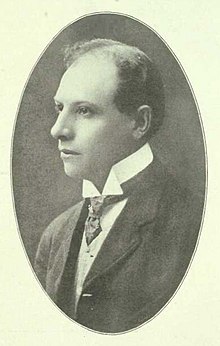Walter William LaChance
| Walter William LaChance | |
|---|---|
 |
|
| Born | April 12, 1870 Brockville, Ontario |
| Died | September 23, 1951 Fonthill, Ontario |
| Nationality | Canadian |
| Occupation | Architect |
| Practice | Solo practitioner, also French and LaChance (Cleveland) Gregg and LaChance (Cleveland) LaChance and Howenstein (Saskatoon) White and LaChance (Niagara Falls, New York) LaChance and Kearns (Welland, Ontario) |
| Buildings |
Flanagan House Hotel (1907) Saskatoon, Saskatchewan |
Flanagan House Hotel (1907)
Now Hotel Senator
Saskatoon, Saskatchewan
Walter William LaChance (1870-1951) was a Canadian architect best known for his designs of rural schools, although he also designed numerous buildings of other types. His commissions were concentrated in Cleveland, Ohio, Hamilton, Ontario, Welland, Ontario, and various communities in Saskatchewan. While his practice was varied in terms of building type, he designed at least 16 schools for various Saskatchewan communities from 1906 to 1914. He was also the author of two books, Modern Schoolhouses (Toronto, 1919) and Schoolhouses and Their Equipment (Niagara Falls, New York, 1925).
While LaChance received numerous commissions, some of them for large buildings, his career was marked by a lack of stability. He moved his architectural practice from city to city numerous times during his career, and was a partner in five different partnerships, all of them short-lived.
On April 12, 1870, LaChance was born in Brockville, Ontario. He moved to Cleveland, Ohio, where he claimed to have graduated from the Case School of Applied Science (predecessor to Case Western Reserve University) in 1884, although there are serious doubts about whether he did, in fact, graduate. If LaChance's claim is truthful, this means he would have received his degree at age 14 or 15.
LaChance next moved to Virginia and Georgia where his practice consisted mainly of designing jails. In a 1909 advertisement by LaChance, he listed numerous buildings he claimed to have designed, of which seven were jails in Virginia, West Virginia, Ohio, and Georgia. Apart from LaChance's self-promotional efforts, little is known about this stage of his career, and the fact that he would have been a teenager during this period raises a number of questions.
In 1889, LaChance returned to Cleveland and worked for the architectural firm, Cramer and Fugman, until 1890. Next, he worked at Van Dorn Iron Works of Cleveland, where he patented an electric lock for prison doors. Following his employment at the iron works, LaChance conducted his architectural practice in Cleveland, both as a solo practitioner as well as in two short-lived partnerships. One partnership was with Alfred A. French (French and LaChance), and another was with Vincent E. Gregg (Gregg and LaChance).
...
Wikipedia
